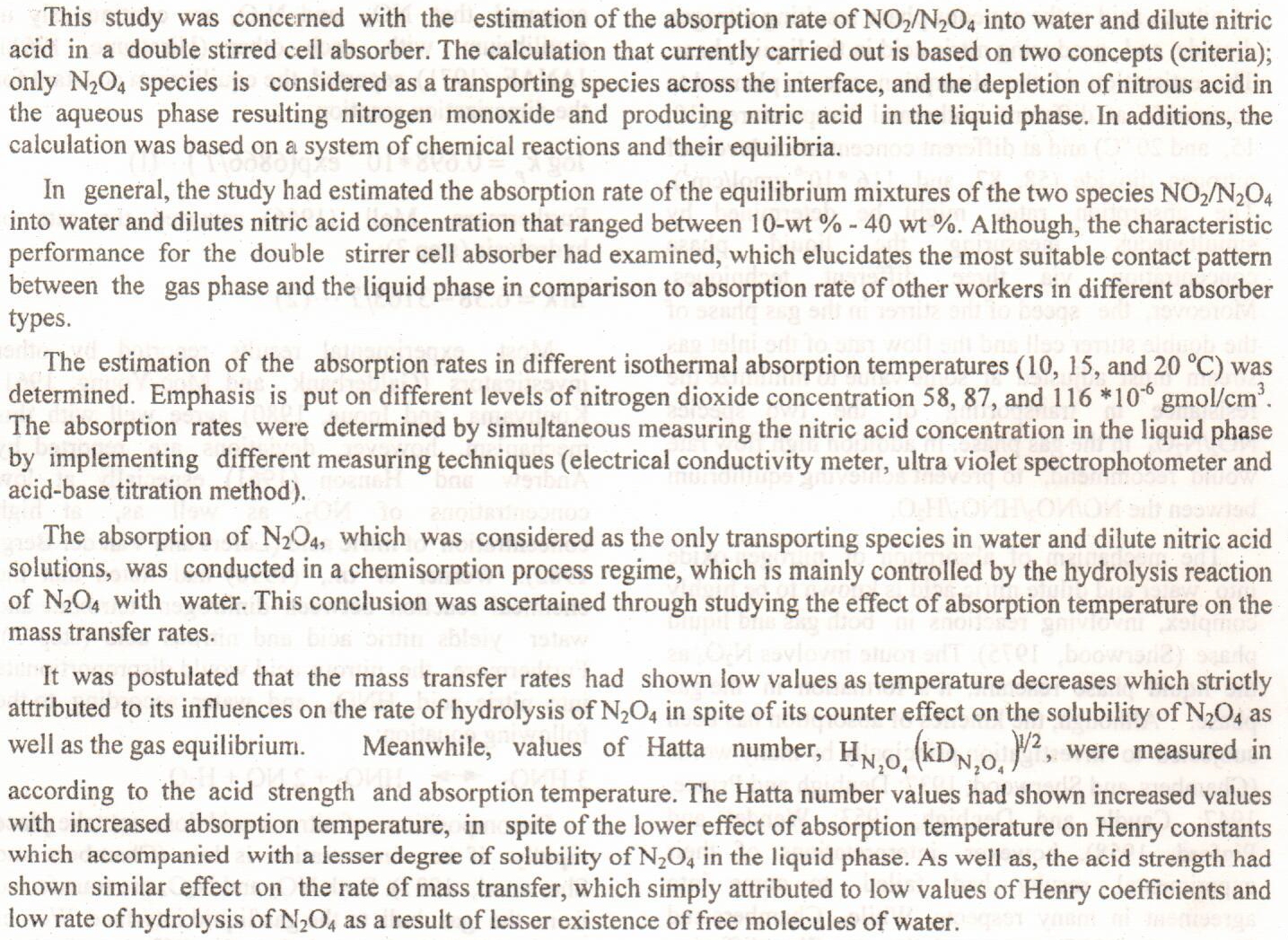
Synthesis three organic inhibitors for carbon steel corrosion: 2-(propylthio)-1H-benzo[d]imidazole (PTBI), 2-(allylthio)- 1H-benzo[d]imidazole (ATBI) and 2-(prop-2-ynylthio)-1H-benzo[d]imidazole (YTBI) were prepared from reaction of 2-mercapto benzimidazole with different alkyl halide. The melting point and TLC were used to confirm the purity of the inhibitors as well as using the [FTIR, 1H-NMR and 13C-NMR] for the identify structures. The synthesized inhibitors were examined by potentiostatic polarization measurement as corrosion inhibitors of carbon steel in acidic media [1M H2SO4 ].The polarization measurement results showed that the mixed type inhibitors. In addition, the efficiency of inhibitors (YTBI) were studied at different con
... Show MoreMefenamic acid belongs to non-steroidal anti-inflammatory drugs that are used widely for the treatment of analgesia. Our aim from this study is to establish a new assay for the quantitative determination of mefenamic acid (MFA) in the pharmaceutical sample by two sensitive and rapid flow injection-fluorometric methods. A homemade fluorometer was used in fluorescence measurements, which using solid-state laser diode 405 and 532 nm as a source, combined with a continuous flow injection technique. The first method depends on the effect of MFA on calcein blue (CLB) fluorescence at 405 nm. Another method is a study of rhodamine-6G (Rh-6G) fluorescence after adding MFA, and recording at 532 nm. Optimum parameters as fluorescent dye concen
... Show More (5)
(5)
 (4)
(4)
One of the most important challenges facing the designers of the sewerage system is the corrosion of sewers due to the influence of sewerage contaminates which lead to failure of the main lines of sewers. In this study, a reference mix of 1: 1.5: 3 was used and the 4% Flocrete PC200 by weight of cement was added to the same mixing ratio in the second mixture. Twenty-four samples were tested for each mixture, 12 of which were used to compression strength test in ages (7, 14 and 28) day and six samples were submerged after 28 days of wet treatment at (5 and 10) % concentrations of sulfuric acid. The other six samples were painted after 28 days of wet treatment with coating Polyurethane and after 24 hours were flooded with a concentrat
... Show MoreAsthma is a chronic respiratory disorder in which immunological and structural cells play a role. The limits of conventional medicines necessitate the development of innovative therapeutic techniques for asthma. In the present study, we investigated the possible protective effect of cinnamic acid (CA) on ovalbumin-induced asthma in a mouse model. Sixty albino male mice BALB/c type weighing (20-30) grams were chosen at random and divided into five groups each one contains 12 animal: Group I: PBS/liquid paraffin control. Group II: asthma model group. Group III: cinnamic acid control group; mice received cinnamic acid (50 mg/kg) in liquid paraffin orally by gavage. Group IV: asthma model / group of (25 mg / kg) cinnamic acid; mice received
... Show More (2)
(2)
 (1)
(1)
Wheat straw was modified with malonic acid in order to get low cost adsorbent have a good ability to remove copper and ferric ions from aqueous solutions, chemical modification temperature was 120°C and the time was 12 h. Parameters that affect the adsorption experiments were studied and found the optimum pH were 6 and 5 for copper and iron respectively and the time interval was 120 min and the adsorbent mass was 0.1 g. The values for adsorption isotherms parameters were determined according to Langmuir [qmax were 54.64 and 61.7 mg/g while b values were 0.234 and 0.22 mg/l] , Freundlich [Kf were 16.07 and 18.89 mg/g and n were 2.77 and 3.16], Temkin [B were 0.063 and 0.074 j/mol and At were 0.143 and 1.658 l/g] and for Dubinin-Radushkev
... Show MoreRe-use of the byproduct wastes resulting from different municipal and industrial activities in the reclamation of contaminated water is real application for green projects and sustainability concepts. In this direction, the synthesis of composite sorbent from the mixing of waterworks and sewage sludge coated with new nanoparticles named “siderite” (WSSS) is the novelty of this study. These particles can be precipitated from the iron(II) nitrate using waterworks sludge as alkaline agent and source of carbonate. Characterization tests using X-ray diffraction (XRD), scanning electron microscopy (SEM) and energy dispersive spectroscopy (EDS) mapping revealed that the coating process was c
 (39)
(39)
 (32)
(32)
KE Sharquie, AA Noaimi, HA Al-Mudaris, Journal of Cosmetics, Dermatological Sciences and Applications, 2012 - Cited by 6
<span lang="EN-GB">This paper highlights the barriers that have led to a delay in the implementation of E-Health services in Iraq. A new framework is proposed to improve the E-Health sector using a SECI model which describes how explicit and tacit knowledge is generated, transferred, and recreated in organizations through main stages (socialization, externalization, combination and internalization). Class association rules (CARs) is integrated to mine the SECI model by extracting related rules which correspond to the medical advice. The proposed framework (SECICAR) can be done through a web portal to assemble healthcare professionals, patients in one environment. SECICAR will be applied to the hypertension community to show th
... Show More (6)
(6)
 (5)
(5)
 (3)
(3)
 (1)
(1)
A phytoremediation experiment was carried out with kerosene as a model for total petroleum hydrocarbons. A constructed wetland of barley was exposed to kerosene pollutants at varying concentrations (1, 2, and 3% v/v) in a subsurface flow (SSF) system. After a period of 42 days of exposure, it was found that the average ability to eliminate kerosene ranged from 56.5% to 61.2%, with the highest removal obtained at a kerosene concentration of 1% v/v. The analysis of kerosene at varying initial concentrations allowed the kinetics of kerosene to be fitted with the Grau model, which was closer than that with the zero order, first order, or second order kinetic models. The experimental study showed that the barley plant designed in a subsu
... Show More (10)
(10)
